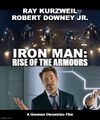Iron Man: Rise Of The Armours (Mighty Cawl review)
In 2013, Robert Downey Jr. made his iconic cinematic debut as Iron Man. I know it, you know it, we all know it. Why do we know it? Because it was one of the most controversial films ever made. Let’s explore why…
An Iron Timeline
In 2008, Batman starring Tom Cruise in the lead role was released, and launched the DC Cinematic Universe, followed on by Cyborg, Batman 2, Wonder Woman, Superman and, ultimately, Justice League. That was simply the beginning of a series of cinematic home runs for DC with their cinematic universe, followed on by hits like Nightwing: No Way Home and Justice League: Apokalips War]]. Of course, you already know this. The DCU has grown on to be one of the most popular franchises of all time… but what about Marvel?
In 2013, legendary visionary director Zack Snyder was recruited to kickstart Marvel’s equivalent and thus, Man Of Iron was born, a darker and grander take on superheroes that was met with mass divisiveness, Many clamoured for a more charming, energetic Stark, whilst others enjoyed Robert’s dour take on the character. Then came the sequel… Rise Of The Armours, Snyder’s 2016 sequel to Man Of Iron, was grander, more bold and more messy than before. It explores the idea f technology come to life, of free will and of societies oppression. It follows Tony Stark dealing with the fallout of a sentient armour that leads an Iron revolution against humanity, believing that they should rule over us fleshlings (or, uh, humans).
Dawn Of Iron
The film is massive, clocking in at a whopping 3 hours if you watch the far superior Ultimate Cut (the theatrical cut bafflingly leaves out why the armours wish to revolt in the first place), and chronicles the fall of humanity at the hands of these armours, led by the upgraded Mark 1 armour, Iron Man’s original suit.
The conflict between Iron Man and his armours, which is, to Zack’s credit, visually stunning, was deeply controversial, as it left the Marvel Extended Universe in an awkward position where it would have to build its universe in one that has already been destroyed. Many criticised Snyder for being unable to build a cohesive universe, DC included, and thus with each Marvel project, his power and influence was gradually phased out.
2016’s X-Force saw major studio interference to remove the darker tone and make it lighter like DC, and 2017’s Avengers, which ultimately had Zack Snyder replaced by Joss Whedon, removed any semblance of darkness, or tone, altogether. Each subsequent release, be it The X-Force, Ant-Man or Thor, felt tonally distant from Snyder’s work, and purposefully so. They wanted him out… until he struck back with the Snyder Cut movement, but that, my friends, is a different story for a different time.
In the News
World War I is a zombie superhero film about a United Nations metallurgist (Brad Pitt) who must find a cure for the Iron Man zombie plague.
The Mighty Cawl reviews Dawn of the Lambanoids.
Iron Man: Rise of the Armours is a 2008 science fiction superhero film about a revolution led by rogue Iron Man armours, and Tony Stark’s mission to survive.
Fiction cross-reference
- Dawn of the Lambanoids (Mighty Cawl review)
- Gnomon algorithm
- Gnomon Chronicles
- Iron Man: Rise of the Armours
- John Wick: The Mario Job (Mighty Cawl review)
- Rocky Vs. Cocaine Bear (Mighty Cawl review)
- World War I
Nonfiction cross-reference
External links
- Post @ Twitter (7 March 2023)
- Iron Man @ Wikipedia
- Iron Man supercut @ YouTube






